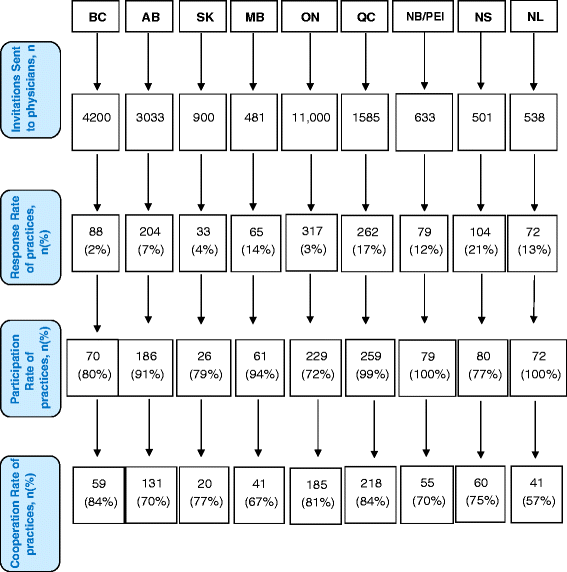An international cross-sectional survey on the Quality and Costs of Primary Care (QUALICO-PC): recruitment and data collection of places delivering primary care across Canada
- PMID: 25879427
- PMCID: PMC4339081
- DOI: 10.1186/s12875-015-0236-7
An international cross-sectional survey on the Quality and Costs of Primary Care (QUALICO-PC): recruitment and data collection of places delivering primary care across Canada
Abstract
Background: Performance reporting in primary health care in Canada is challenging because of the dearth of concise and synthesized information. The paucity of information occurs, in part, because the majority of primary health care in Canada is delivered through a multitude of privately owned small businesses with no mechanism or incentives to provide information about their performance. The purpose of this paper is to report the methods used to recruit family physicians and their patients across 10 provinces to provide self-reported information about primary care and how this information could be used in recruitment and data collection for future large scale pan-Canadian and other cross-country studies.
Methods: Canada participated in an international large scale study-the QUALICO-PC (Quality and Costs of Primary Care) study. A set of four surveys, designed to collect in-depth information regarding primary care activities was collected from: practices, providers, and patients (experiences and values). Invitations (telephone, electronic or mailed) were sent to family physicians. Eligible participants were sent a package of surveys. Provincial teams kept records on the number of: invitation emails/letters sent, physicians who registered, practices that were sent surveys, and practices returning completed surveys. Response and cooperation rates were calculated.
Results: Invitations to participate were sent to approximately 23,000 family physicians across Canada. A total of 792 physicians and 8,332 patients from 772 primary care practices completed the surveys, including 1,160 participants completing a Patient Values survey and 7,172 participants completing a Patient Experience survey. Overall, the response rate was very low ranging from 2% (British Columbia) to 21% (Nova Scotia). However, the participation rate was high, ranging from 72% (Ontario) to 100% (New Brunswick/Prince Edward Island and Newfoundland & Labrador).
Conclusions: The difficulties obtaining acceptable response rates by family physicians for survey participation is a universal challenge. This response rate for the QUALICO-PC arm in Canada was similar to rates found in other countries such as Australia and New Zealand. Even though most family physicians operate as self-employed small businesses, they could be supported to routinely submit data through a collective effort and provincial mandate. The groundwork in setting up pan-Canadian collaboration in primary care has been established through this study.
Figures

Similar articles
-
Alignment of Canadian Primary Care With the Patient Medical Home Model: A QUALICO-PC Study.Ann Fam Med. 2017 May;15(3):230-236. doi: 10.1370/afm.2059. Ann Fam Med. 2017. PMID: 28483888 Free PMC article.
-
Using the CollaboraKTion framework to report on primary care practice recruitment and data collection: costs and successes in a cross-sectional practice-based survey in British Columbia, Ontario, and Nova Scotia, Canada.BMC Fam Pract. 2018 Jun 13;19(1):87. doi: 10.1186/s12875-018-0782-x. BMC Fam Pract. 2018. PMID: 29898667 Free PMC article.
-
Primary health care organizational characteristics associated with better accessibility: data from the QUALICO-PC survey in Quebec.BMC Fam Pract. 2018 Dec 3;19(1):188. doi: 10.1186/s12875-018-0871-x. BMC Fam Pract. 2018. PMID: 30509205 Free PMC article.
-
Improving care for advanced COPD through practice change: Experiences of participation in a Canadian spread collaborative.Chron Respir Dis. 2018 Feb;15(1):5-18. doi: 10.1177/1479972317712720. Epub 2017 Jun 14. Chron Respir Dis. 2018. PMID: 28612657 Free PMC article. Review.
-
Contrasting current challenges from the Brazilian and Canadian national health systems: The Besrour Papers: a series on the state of family medicine in Canada and Brazil.Can Fam Physician. 2019 Dec;65(12):890-896. Can Fam Physician. 2019. PMID: 31831488 Free PMC article. Review.
Cited by
-
Alignment of Canadian Primary Care With the Patient Medical Home Model: A QUALICO-PC Study.Ann Fam Med. 2017 May;15(3):230-236. doi: 10.1370/afm.2059. Ann Fam Med. 2017. PMID: 28483888 Free PMC article.
-
The role of registered nurses in primary care and public health collaboration: A scoping review.Nurs Open. 2020 Apr 14;7(4):1197-1207. doi: 10.1002/nop2.496. eCollection 2020 Jul. Nurs Open. 2020. PMID: 32587740 Free PMC article.
-
Canadian family physician job satisfaction - is it changing in an evolving practice environment? An analysis of the 2013 National Physician Survey database.BMC Fam Pract. 2018 Jun 23;19(1):100. doi: 10.1186/s12875-018-0786-6. BMC Fam Pract. 2018. PMID: 29935531 Free PMC article.
-
Process quality indicators in family medicine: results of an international comparison.BMC Fam Pract. 2015 Dec 2;16:172. doi: 10.1186/s12875-015-0386-7. BMC Fam Pract. 2015. PMID: 26631138 Free PMC article.
-
Computer use in primary care practices in Canada.Can Fam Physician. 2017 May;63(5):e284-e290. Can Fam Physician. 2017. PMID: 28500211 Free PMC article.
References
-
- College of Family Physicians of Canada, Canadian Medical Association, Royal College of Physicians and Surgeons of Canada. 2007 National Physician Survey [Internet]. 2007 [cited 2014 Aug 19]. Available from: http://nationalphysiciansurvey.ca/surveys/2007-survey/
-
- Centers for Disease Control and Prevention. Ambulatory health care data. Survey instruments: NAMCS survey instruments [Internet]. Atlanta, GA: Centers for Disease Control and Prevention; 2011. Available from: http://www.cdc.gov/nchs/ahcd/ahcd_survey_instruments.htm.
Publication types
MeSH terms
Grants and funding
LinkOut - more resources
Full Text Sources
Other Literature Sources

